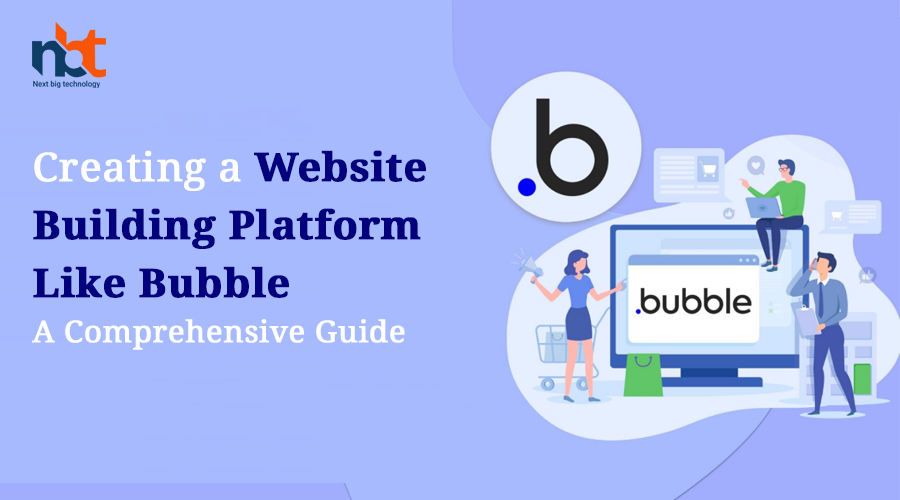In the digital era, the ability to create websites without coding knowledge has become a game-changer for individuals and businesses. Platforms like Bubble have paved the way for visual and intuitive website development, empowering users to build complex web applications with ease. This guide takes you through the process of creating a website building platform similar to Bubble, outlining key features, technology stack, development steps, challenges, and opportunities.
Table of Contents
Introduction to Visual Website Building Platforms
- The Rise of No-Code and Low-Code Development Tools
- Role of Bubble and Similar Platforms in Transforming Web Development
Key Features of a Bubble-Like Website Building Platform
Visual Drag-and-Drop Editor
- Intuitive Interface for Designing User Interfaces
- Allowing Users to Arrange Elements Without Coding
Responsive Design and Layouts
- Ensuring Websites Adapt to Various Screen Sizes
- Enabling Easy Creation of Mobile-Friendly Interfaces
Workflow Automation
- Building Logic and Functionality Without Code
- Enabling Dynamic Interactions Between Elements
Database Management
- Visual Database Design for Storing and Retrieving Data
- Connecting Data to UI Elements for Real-Time Updates
User Authentication and Access Control
- Setting Up User Registration and Login Processes
- Managing User Roles and Permissions
API Integration
- Connecting to External APIs for Data and Functionality
- Expanding Platform Features Through Third-Party Integrations
App Deployment and Hosting
- Allowing Users to Publish and Host Their Applications
- Providing Scalable Hosting Solutions
Technology Stack for Building a Bubble-Like Platform
Frontend Development
- HTML, CSS, JavaScript: Foundational Web Development Languages
- React, Angular, Vue.js: Popular Frontend Frameworks
Backend Development
- Node.js, Python, Ruby: Backend Language Options
- Express.js, Django, Ruby on Rails: Backend Frameworks
Database Management
- SQL or NoSQL Databases (e.g., PostgreSQL, MongoDB)
- Storing User Data, Application Logic, and Content
Cloud Infrastructure and Hosting
- AWS, Google Cloud, Microsoft Azure: Cloud Service Providers
- Ensuring Scalability, Reliability, and Performance
No-Code Logic Engine
- Developing a Visual Logic Engine for Workflow Automation
- Creating a User-Friendly Environment for Logic Design
Steps in Building a Bubble-Like Website Building Platform
Step 1: Ideation and Conceptualization
- Defining Target Users and Use Cases
- Outlining Core Features and Platform Objectives
Step 2: Design and User Experience
- Crafting an Intuitive User Interface (UI)
- Wireframing and Designing Visual Elements
Step 3: Frontend Development
- Building the Drag-and-Drop Editor Interface
- Implementing Responsive Design Principles
Step 4: Backend Development
- Developing User Authentication and Access Control
- Building APIs for Database Interaction and Logic Execution
Step 5: Database Management
- Creating a Visual Database Design Interface
- Connecting UI Elements to Database Fields
Step 6: Logic Engine Development
- Building a No-Code Logic Engine for Workflow Automation
- Enabling Dynamic Interactions and Data Processing
Step 7: API Integration
- Implementing API Connectivity for Third-Party Integrations
- Enabling Users to Extend Functionality Through APIs
Step 8: App Deployment and Hosting
- Setting Up Scalable Hosting Infrastructure
- Allowing Users to Publish and Host Their Applications
Step 9: Testing and Quality Assurance
- Rigorous Testing of Features and Logic Engine
- Addressing Bugs, Performance Issues, and User Feedback
Challenges and Considerations in Building a Bubble-Like Platform
Complexity of Logic Engine
- Designing a User-Friendly Logic Interface for Non-Coders
- Ensuring Flexibility and Scalability of Logic Design
User Experience
- Balancing Flexibility with Guided Design Principles
- Providing Clear Tutorials and Onboarding
Scalability and Performance
- Designing for High Traffic and Concurrent Users
- Load Balancing and Efficient Data Retrieval
Third-Party API Integrations
- Ensuring Smooth Integration with Various APIs
- Managing Changes and Updates in External APIs
Benefits and Opportunities of a Bubble-Like Platform
Empowerment Through No-Code Development
- Enabling Non-Developers to Create Powerful Applications
Rapid Prototyping and MVP Development
- Accelerating Application Development and Testing
Business Opportunities
- Monetization through Subscription Plans and Premium Features
Education and Skill Enhancement
- Fostering Learning and Innovation in App Development
Real-Life Examples of Successful Visual Development Platforms
Adalo
- Visual Development Platform for Web and Mobile Apps
OutSystems
- Low-Code Platform for Enterprise Application Development
Appgyver
- No-Code Platform for Building Responsive Web Apps
Future Trends in Visual Website Building Platform Development
AI-Enhanced Logic Engines
- Integrating Artificial Intelligence for Advanced Automation
Enhanced Collaboration Features
- Facilitating Real-Time Collaboration Among Users
Voice and AR/VR Integration
- Exploring Voice Commands and Immersive Experiences
Conclusion
Building a visual website development platform akin to Bubble involves a deep understanding of user needs, design principles, and technology integration. By navigating the key features, technology stack, development process, challenges, and benefits, you can embark on a journey to create a platform that empowers users to bring their digital ideas to life without coding. As technology continues to evolve, visual development platforms stand as a testament to the democratization of application development and the limitless possibilities of innovation.










